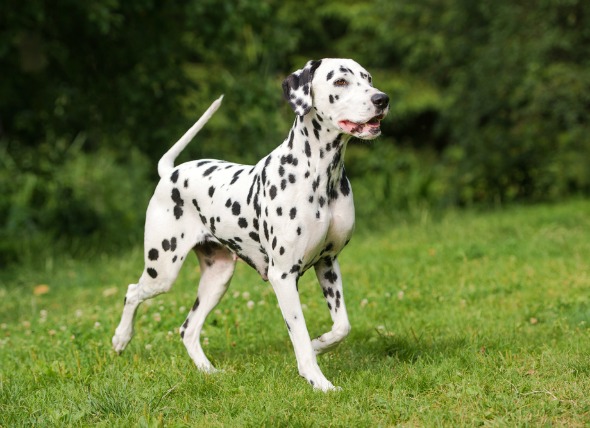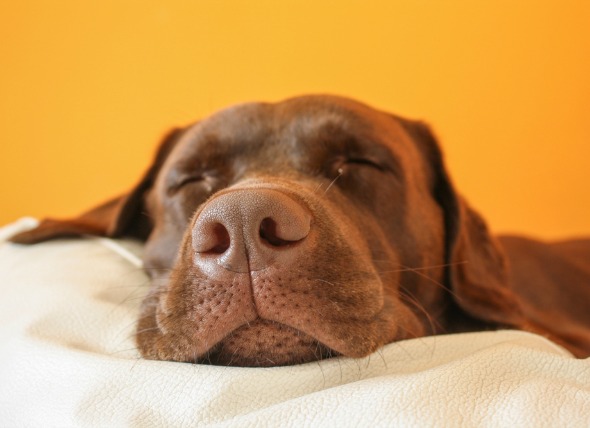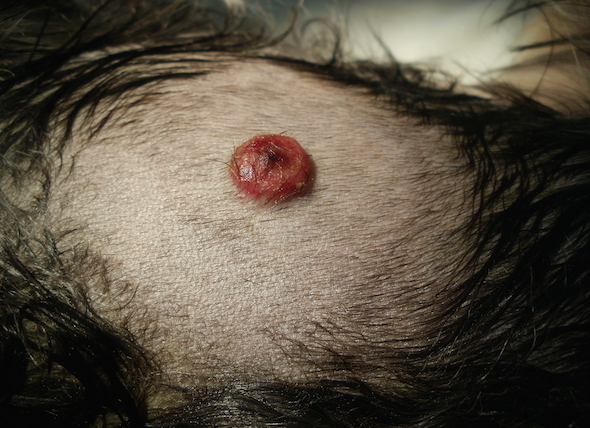

The epidermis, or skin, consists of several layers. The outer layer is made up of scale like cells called the squamous epithelium. This layer of tissue covers the surface of much of the body, and lines the cavities of the body. A squamous cell carcinoma is a type of cancer that originates in the squamous epithelium. It may appear to be a white skin mass, or a raised bump on the skin. Often the raised mass will necrotize in the center and ulcerate, with occasional bleeding.
As carcinomas are characteristically malignant and particularly invasive, it is essential to have this form of skin cancer diagnosed and treated without delay. Cutaneous squamous cell carcinomas are typically fast growing tumors that get bigger with time and resist healing. If the ulcers are diagnosed before they have had an opportunity to become malignant, this condition may be treated effectively in some cases.
Squamous cell carcinomas are seen more in dogs that live at high altitudes and in dogs that spend a lot of time in the sun. Scottish terriers, Pekingese, boxers, poodles, Norwegian elkhounds, dalmatians, beagles, whippets, and white English bull terriers seem to get this kind of skin cancer more that other breeds of dogs. Large breed black dogs are more prone to squamous cell carcinomas on their toes than other types of dogs, and dogs that have light colored skin and hair are more prone to this type of skin cancer than other types of dogs. As with most forms of carcinoma, cutaneous squamous cell carcinoma is most commonly seen in older dogs.
Sores
Growths or Tumors
Growths in areas where hair is white and skin is light colored
You will need to give your veterinarian a thorough history of your dog's health, onset of symptoms, and possible incidents that might have precipitated this condition, such as a recent flea infestation that would have left sores from vigorous scratching. Once this history has been detailed, your veterinarian will conduct a thorough physical examination on your dog, paying close attention to any growths on the skin or any sores that have not healed in several months. Your dog's lymph nodes will be palpated to determine if they are swollen, an indication that the body is fighting an invasive disease or infection, and a sample of lymph fluid will be taken for laboratory analysis. The presence of cancerous cells in the lymph glands will be indicative of metastasis through the body. Basic laboratory tests include a complete blood count and biochemical profile to confirm that your dog's organs are functioning normally.
Because carcinomas are characteristically malignant and metastasize quickly, your veterinarian may also order x-ray images of your dog's chest and abdomen so that a visual inspection can be made of the lungs and organs. Likewise, if your dog has a tumor on one of its legs, your veterinarian will want to take x-rays of the leg to see if the tumor has spread to the bone underneath it.
Standard biopsies will be taken of the growth or sore. This is the best way to determine exactly what kind of tumor your dog has.
The course of treatment will depend on how large your dog's tumor is and how many tumors there are. In some cases, when sores are diagnosed before they become cancerous, they can be treated with topical medication.
If your dog only has one small tumor that has not spread to other organs, it may be removed by cryosurgery - freezing technique, or with a special type of light therapy called photodynamic therapy. It may also be surgically removed.
If your dog has a large tumor, it will be treated with surgery. During surgery, the tumor and a lot of the tissue surrounding it will be removed to ensure that all of the caner cells are removed. In some cases, so much tissue may be removed during surgery that skin will need to be taken from another area of the body and used to cover the area where the tumor was, a technique called skin grafting.
Some cases will result in a more severe removal of tissue. For example, tumors that are on the toes require amputation of the affected toe, and tumors on the nose will require a partial removal of the nose. If the tumor is found on the ear, part of the ear will be removed. These types of surgeries will result in a cosmetically different appearance for your dog, but otherwise, dogs recover well from these surgeries.
If the tumor cannot be completely removed, your veterinarian may recommend radiation or chemotherapy after surgery. Sometimes, when surgery is impractical, chemotherapy and radiation are used solely to treat tumors. In this case, the chemical treatment will keep the tumor from growing as quickly and help to make your cat more comfortable.
After surgery, or while your dog is being treated for the tumor, you should expect your dog to feel sore. Your veterinarian will give you pain medication for your dog to help minimize discomfort. Use pain medications with caution; one of the most preventable accidents with pets is overdose of medication. Follow all directions carefully. You will need to limit your dog's activity while it heals, setting aside a quiet place for it to rest, away from household activity, children, and other pets. It might be practical to consider cage rest for your dog, to limit its physical activity. Your veterinarian will tell you when it is safe for your dog to take exercise again. Until then, only take your dog for short walks.
It is important to monitor your dog's food and water intake while it is recovering. If your dog does not feel up to eating, you may need to use a feeding tube or a high protein liquid supplement so that it is getting all of the nutrition it needs to completely recover. Your veterinarian will show you how to use the feeding tube correctly, and will assist you in setting up a feeding schedule.
If you are treating your dog with a topical medication for its sores, it is important to follow all of your veterinarian’s instructions. You will probably need to wear gloves to apply the medication.
After your cat has recovered, your veterinarian will set up a schedule for regular progress checks. Recurrence is possible, so your doctor will check for any new tumors, and x-rays of the chest and abdomen will be taken to see if there are any new tumors in the lungs or internal organs.
A full recovery will be dependent on the size and location of the tumor.
Limit the amount of time your dog spends in the sun, especially between the hours of 10:00 am and 2:00 pm, when the sun is at its highest and the rays most damaging. When you must take your dog outdoors during daylight hours, apply sunscreen to your dog's ears, nose, and other areas that are either lightly furred or colored before going out in the sun. In some cases, tattoos can be applied to light colored skin as a permanent sunscreen. If you notice any new sores or masses, take your dog to the veterinarian as soon as possible so that it can be treated immediately.
 Throat Cancer (Chondrosarcoma) in Dogs
Chondrosarcoma of the Larynx and Trachea in Dogs
Throat Cancer (Chondrosarcoma) in Dogs
Chondrosarcoma of the Larynx and Trachea in Dogs
 Breathing Problem in Short-Nose Breed Dogs
Brachycephalic Airway Syndrome in Dogs
Brac
Breathing Problem in Short-Nose Breed Dogs
Brachycephalic Airway Syndrome in Dogs
Brac
 Nose and Sinus cancer (Squamous Cell Carcinoma) in Dogs
Nasal Squamous Cell Carcinoma in Dogs
The respira
Nose and Sinus cancer (Squamous Cell Carcinoma) in Dogs
Nasal Squamous Cell Carcinoma in Dogs
The respira
 Fatty Skin Tumors in Dogs
Lipoma in Dogs
Lipomas are subcutaneous (undernea
Fatty Skin Tumors in Dogs
Lipoma in Dogs
Lipomas are subcutaneous (undernea
 Staph Infection in Dogs
Staphylococcal Infections in Dogs
The Staphylococ
Staph Infection in Dogs
Staphylococcal Infections in Dogs
The Staphylococ
Copyright © 2005-2016 Pet Information All Rights Reserved
Contact us: www162date@outlook.com